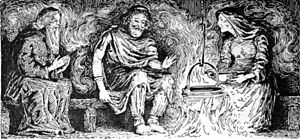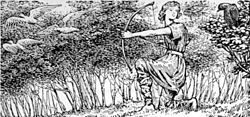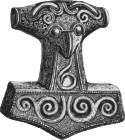- Rígsþula
-
 "Rig in Great-grandfather's Cottage" (1908) by W. G. Collingwood
"Rig in Great-grandfather's Cottage" (1908) by W. G. Collingwood
Rígsþula or Rígsmál, "Lay of Ríg," is an Eddic poem in which a Norse god named Ríg or Rígr , described as "old and wise, mighty and strong" fathers the classes of mankind. The prose introduction states that Rígr is another name for Heimdall, who is also called the father of mankind in Völuspá.
In Rígsþula, Rig wanders through the world and fathers the progenitors of the three classes of human beings as conceived by the poet. The youngest of these sons inherits the name or title "Ríg" and so in turn does his youngest son, Kon the Young or Kon ungr (Old Norse: konungr, king). This third Ríg was the first true king and the ultimate founder of the state of royalty as appears in the Rígsþula and in two other associated works. In all three sources he is connected with two primordial Danish rulers named Dan and Danþír.
The poem Rígsþula is preserved incomplete on the last surviving sheet in the 14th-century Codex Wormianus, following Snorri Sturluson's Prose Edda.[1] A short prose introduction explains that the god in question was Heimdall, who wandered along the seashore until he came to a farm where he called himself Ríg. The name Rígr appears to be the oblique case of Old Irish rí, ríg "king", cognate to Latin rex , Sanskrit rajan.[2] and Gothic reiks.[3]
The identification of Rígr with Heimdall is supported by his characterization as an ancestor, or kinsman, of humankind in the first two lines of the Eddic poem Völuspá:'
- I ask for a hearing
- of all the holy races
- Greater and lesser
- kinsmen of Heimdall
However, some scholars, including Finnur Jónsson and Rudolf Simek, have suggested this is a role more appropriate to Óðinn and that the Eddic tradition has thus transferred the name Rígr from him to Heimdall.[2][4] Since Rígsþula is only preserved in a 14th-century manuscript, it is also plausible that the prose introduction was added by the compiler to conform it to the opening of Völuspá.[1]
Contents
Synopsis
 "Heimdall in Rig's shape" by Carl Larsson
"Heimdall in Rig's shape" by Carl Larsson
Rígr was walking along the shore and came to a farm-hut owned by Ái (great-grandfather) and Edda (great-grandmother). They offered him shelter and poor, rough food for a meal. That night Rígr slept between the pair in their bed and then departed. Nine months later, Edda gave birth to a son who was svartan (dark). They named him Þræll (thrall, serf, or slave). Þræll grew up strong but ugly. He married a woman named Thír (slave girl or bondswoman), and they had twelve sons and nine daughters with names mostly suggesting ugliness and squatness. They became the race of serfs.
Traveling further, Rígr came across a pleasant house where a farmer/craftsman, Afi (grandfather) lived with his wife Amma (grandmother). This couple gave him good food and also let him sleep between them. Nine months later, a son, Karl (churl or freeman) was born, whose face and hair were red. Karl married a woman named Snör (daughter-in-law), and they had twelve sons and ten daughters with names mostly suggesting a neat appearance or being of good quality. One of the names is smiðr (smith). These became the ancestors of the lesser farmers and herdsmen.
Traveling further, Rígr came to a mansion inhabited by Faðir (Father) and Móðir (Mother). They gave him excellent food served splendidly and, nine months later, Móðir gave birth to a beautiful baby named Jarl (earl or noble), whose hair was blond and who was bleikr (bright white in color). When Jarl grew up and began to handle weapons and to use hawks, hounds, and horses, Rígr reappeared, claimed him as his son, gave him his own name of Rígr, made him his heir, taught him runes, and advised him to seek lordship.
Through warfare Jarl became lord of eighteen homesteads with much wealth besides. He also gained the hand of Erna (Brisk), daughter of Hersir (lord). Erna bore eleven sons to Ríg-Jarl but no daughters. All the sons were given high-sounding names, mostly meaning "son." They became the ancestors of the warrior nobility.
The youngest son, named Konr, was the best of them. He alone learned rune-craft as well as other magic and was able to understand the speech of birds, to quench fire, and to heal minds. He also had the strength of eight normal men. His name was Kon the young (Konr ungr in Old Norse), the name and title to be understood as the origin of the Norse word konungr (king) (although this is a false etymology). Konr, like his father, also acquired the name or title of Rígr.
 "The Crow warns Kon" (1908) by W. G. Collingwood
"The Crow warns Kon" (1908) by W. G. Collingwood
One day, when Konr the young was riding through the forest hunting and snaring birds, a crow spoke to him and suggested he would win more if he stopped hunting mere birds and rode to battle against foemen, that he should seek the halls of Dan and Danp, who were wealthier than he. At that point the poem abruptly cuts off.
Theories
A marriage by Konr the young into the family of Dan and Danp seems to be where the tale was headed, as seen in the two other sources that mention this Rígr. According to Arngrímur Jónsson's Latin epitome of the lost Skjöldungasaga:
Ríg (Rigus) was a man not the least among the great ones of his time. He married the daughter of a certain Danp, lord of Danpsted, whose name was Dana; and later, having won the royal title for his province, left as his heir his son by Dana, called Dan or Danum, all of whose subjects were called Danes.[citation needed]
The other tradition appears in chapter 20 of the Ynglinga Saga section of Snorri Sturluson's Heimskringla. The story speaks of King Dygvi of Sweden:
Dygvi's mother was Drótt, a daughter of King Danp, the son of Ríg, who was first called konungr in the Danish tongue. His descendants always afterwards considered the title of konungr the title of highest dignity. Dygvi was the first of his family to be called konungr, for his predecessors had been called dróttinn [chieftain], and their wives dróttning, and their court drótt (war band). Each of their race was called Yngvi, or Ynguni, and the whole race together Ynglingar. Queen Drótt was a sister of King Dan Mikillati, from whom Denmark took its name.[citation needed]
Despite genealogical discrepancies (to be evaded only by imagining more than one Danp and more than one Dan) the accounts relate a common tradition about the origin of the title konungr (king).
Konr the young, whose magical abilities are so emphasized, is as much a magician as a warrior: a magician king, perhaps a sacred king. Dumézil pointed out that Kon alone represents the supernatural function, represented by the brahman caste in India, the flamen function in Rome, the druids in some Celtic cultures, and the clergy in the three estates of medieval Europe. Instead of the three estates of clergy/priest, warrior, and commoner, with serfs outside the system, the Rígsþula presents three estates or castes in which the clergy/priest class has been subsumed within the warrior class and identified with royalty.[5] Also, although in Rome and India the color white is assigned to the sacred and to priests and red to warriors, here the noble warrior is white in color while the red coloration is ascribed instead to the commoner in place of the green, blue, or yellow color assigned to the lower classes in other cultures associated with Proto-Indo-European society. Dumézil saw this as a Germanic adaptation of the Indo-European heritage.[6]
Jean Young and Ursula Dronke, among others, have suggested that the Rígsþula story is Celtic in origin and that the name Rígr is an indication of this.[7]
References
- ^ a b Karl G. Johansson, "Rígsþula och Codex Wormianus: Textens funktion ur ett kompilationsperspektiv," Alvíssmál 8 (1998) 67–84 (pdf) (Swedish) (English summary, p. 84).
- ^ a b Rudolf Simek, trans. Angela Hall, Dictionary of Northern Mythology, Cambridge: Brewer, 1993, repr. 2000, ISBN 0-85991-513-1, p. 264.
- ^ Joseph Wright, Grammar of the Gothic Language, Oxford: Clarendon, 1910, OCLC 162196350, p. 340.
- ^ Jan de Vries, Altgermanische Religionsgeschichte Volume 2, 2nd ed. Berlin: de Gruyter, 1957, repr. 1970, p. 243 (German)
- ^ Georges Dumézil, "The Rígsþula and Indo-European Social Structure (1958)", trans. John Lindow, in Gods of the Ancient Northmen, Ed. Einar Haugen, Publications of the UCLA Center for the Study of Comparative Folklore and Mythology 3, Berkeley: University of California, 1973, ISBN 0520035070, pp. 118–25.
- ^ Dumézil, pp. 124–25. On the colors, see also Ursula Dronke, ed. and trans., The Poetic Edda Volume II: Mythological Poems, Oxford: Clarendon/Oxford University, 1997, ISBN 0-19-811181-9, pp. 187–89.
- ^ Jean Young, "Does Rígsþula Betray Irish Influence?," Arkiv för nordisk filologi 49 (1933) 97–107; Dronke, pp. 202–08.
Sources
- Frederic Amory, "The Historical Worth of Rígsþula," Alvíssmál 10 (2001) 3–20 (pdf)
External links
- Rígsþula in Old Norse and Henry Adams Bellows' translation at voluspa.org
Norse paganism Deities,
heroes,
and figuresOthersAsk and Embla · Dís (Norns · Valkyries) · Dwarf · Einherjar · Elves (Light elves · Dark elves) · Fenrir · Hel · Jörmungandr · Jötunn · Sigurd · Völundr · Vættir
Locations Asgard · Bifröst · Fólkvangr · Ginnungagap · Hel · Jötunheimr · Midgard · Múspellsheimr · Niflheim · Valhalla · Vígríðr · Wells (Mímisbrunnr · Hvergelmir · Urðarbrunnr) · YggdrasilEvents Sources Society See also The Poetic Edda Mythological poems Völuspá · Hávamál · Vafþrúðnismál · Grímnismál · Skírnismál · Hárbarðsljóð · Hymiskviða · Lokasenna · Þrymskviða · Völundarkviða · AlvíssmálNon-Codex RegiusBaldrs draumar · Rígsþula · Hyndluljóð (Völuspá hin skamma) · Svipdagsmál (Grógaldr · Fjölsvinnsmál) · Gróttasöngr · Hrafnagaldr ÓðinsHeroic Lays Codex RegiusHelgi LaysNiflung CycleJörmunrekkr LaysNon-Codex RegiusLater poems Manuscripts See also Categories:- Old Norse literature
- Æsir
- Eddic poetry
Wikimedia Foundation. 2010.
